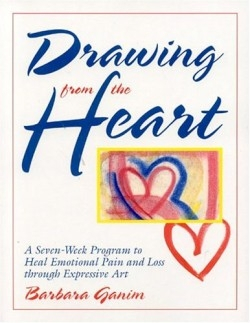Drawing from the Heart
A Seven-Week Program to Heal Emotional Pain and Loss through Expressive Art
Messages from the heart, accessed nonverbally through image-making, hold the power to heal the most painful emotions and deepest wounds, according to the author, who is an arts educator, counselor, and program coordinator at the Expressive Arts Institute at Salve Regina University. Her previous books include Visual Journaling and Art and Healing. Here, she outlines a step-by-step process by which drawing can give voice to the heart, thereby accessing multiple healing pathways.
Part One of the book details the program, previews the seven steps, and suggests materials needed. It includes illustrations and anecdotes from students and workshop participants, all of whom were dealing with devastating pain, loss, or health issues. The case study drawings and journal entries throughout show students traversing the healing path. Readers “witness their struggles as well as their accomplishments.” The results often appear miraculous. In their own words, participants describe how they recognized and tapped into their own deep wells of strength. This section discusses why talking about pain can make things feel worse, how drawing from the heart can change lives, why color is important.
The second part provides exercises for the seven steps: identifying what needs to be healed, accessing primary emotions, acknowledging and transforming loss, getting to the root of fear, dealing with guilt, forgiving, and finally creating healing images. The process starts with setting the healing intention, then shifts back and forth via the exercises between journaling to capture what the mind thinks and drawing what the heart feels. The heart of this work acknowledges that healing with art involves accessing, releasing, and transforming painful emotions. Each exercise begins with connecting breath and body, accessing the awareness of the heart to ask for images that answer the question at hand, then drawing what comes up.
Processing questions at the end of the exercises generate self-awareness, giving the user a complete picture, with the ability to compare, contrast, and finally integrate the differences in how mind and heart discern the problem. These questions also help users uncover the larger meanings, while pointing to new ways of understanding the past and responding to the future.
Users don’t need special artistic talent to benefit from this process. They will find gentle guidance (“There is no wrong way to do it”) and practical tips from an author and expert who declares: “This book is for anyone going through a painful experience.” Since that includes everyone at one time or another, these are tools that will benefit a broad audience of people committed to a path of self-reflection, willing to process emotions and trauma. This is a beautiful, touching, and highly practical guide and a must-have for art therapy, psychology, and self-help shelves.
Reviewed by
Bobbye Middendorf
Disclosure: This article is not an endorsement, but a review. The publisher of this book provided free copies of the book to have their book reviewed by a professional reviewer. No fee was paid by the publisher for this review. Foreword Reviews only recommends books that we love. Foreword Magazine, Inc. is disclosing this in accordance with the Federal Trade Commission’s 16 CFR, Part 255.

